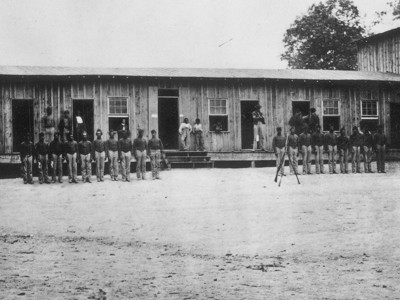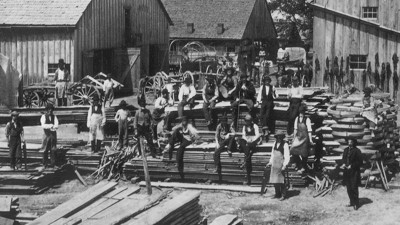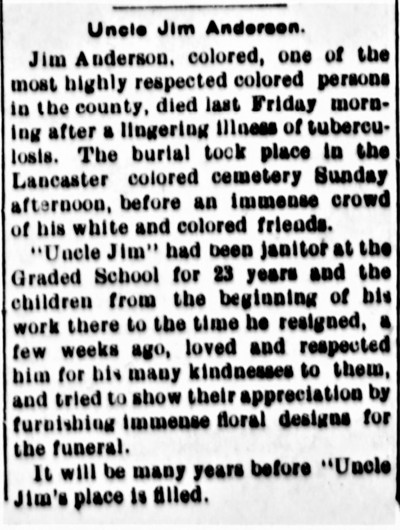

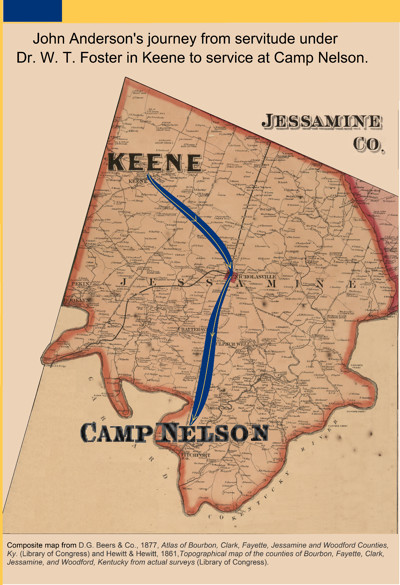
Composite map showing John Anderson’s journey from Keene to Camp Nelson.
Hewitt & Hewitt/Smith Gallup Co. (1861) and D.G. Beers & Co. (1877), courtesy of the Library of Congress.
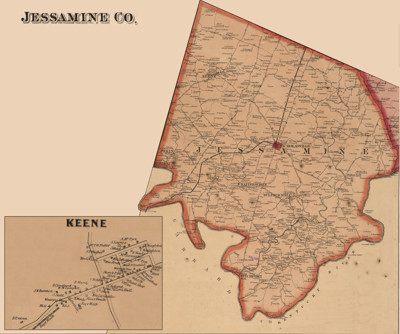
Detail from the 1866 Hewitt & Hewitt/Smith Gallup Co. map of Jessamine County, KY, showing W.T. Foster’s property in the town of Keene, where John Anderson likely grew up.
Courtesy of the Library of Congress.

1860 U.S. Census slave schedule, showing the ages and sexes of people enslaved in Jessamine County. Listed as W.T. Foster’s property are a 45-year-old woman, a young man, aged 18, and a 7-year-old boy. John Anderson likely grew up with these people as family, and the woman was probably his mother, Lydia.
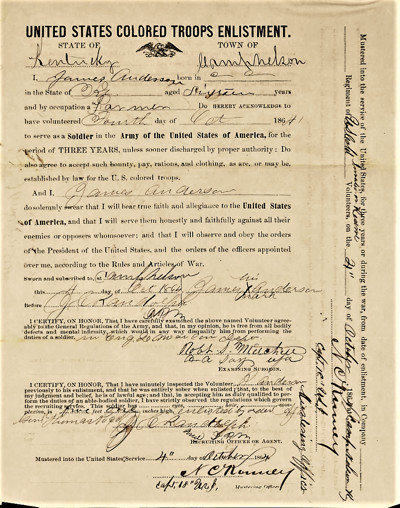
James Anderson’s USCT enlistment papers from Camp Nelson.
National Archives, Civil War Service Records, Colored Troops.
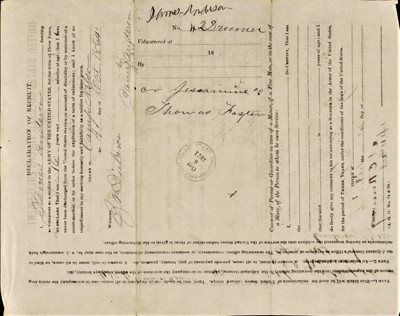
James Anderson’s recruitment papers showing that he was a drummer in the USCT.
National Archives, Civil War Service Records, Colored Troops.

Photograph of Alexander H. Johnson, reputedly the first African American drummer boy to enlist, in his uniform while serving in the 54th Massachusetts Infantry.
circa 1863 – 1865. Massachusetts Historical Society

Photograph of “Taylor” or “Jackson,” a young drummer boy for 78th USCT Infantry stationed in Louisiana.
c1864/1865, Liljenquist Family Collection of Civil War Photographs, Library of Congress.
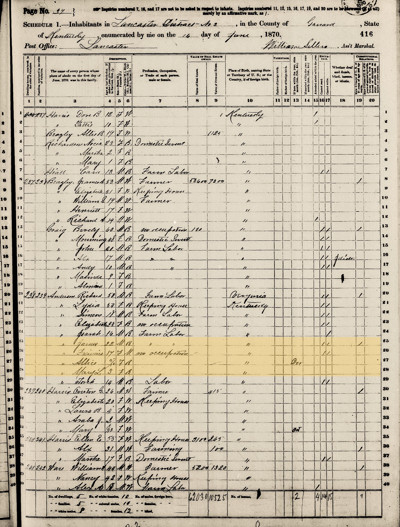
Page from the 1870 U.S. Census, showing James Anderson and his family living with his parents, Richard and Lydia.

Postcard showing Lancaster Courthouse, built in 1868, in front of which James Anderson voted in 1870.
CourtHouseHistory.com; c1868-1914.

Poll book page from the August 1870 election in Lancaster showing James Anderson’s vote for the Republican ticket. Each black voter that declared his vote was noted in the column at the center, presumably so the clerk, a Republican, could keep track of his party’s mobilization effort. Anderson is the sixth black voter on the page.

Poll book page from the August 1876 election highlighting James Anderson’s vote (in blue) and the votes of other black men (in yellow). Note that E.D. Bishop, the town constable candidate for whom most vote, was a Democrat (although, formally, the office of constable was nonpartisan).
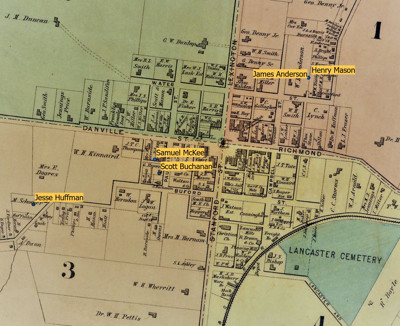
Edited detail from the 1879 Beers and Lanagan map, which shows John Anderson’s likely residence in 1876 and his black neighbors who voted with him in August.
University of Wisconsin-Milwaukee Libraries.
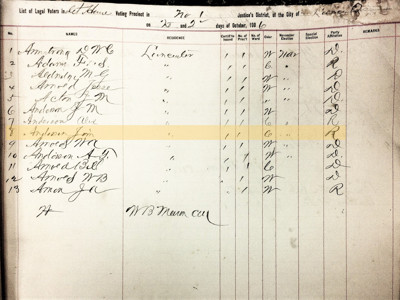
Page from the Garrard County 1906 registration book, showing James “Jim” Anderson’s registration and party affiliation.
James Anderson:
Drumming a Republican (Party) Beat
James Anderson was just 16 years old when he ran away from servitude to join the Union army. He made the 12-mile journey from his owner’s home to the nearest Union recruiting station at Camp Nelson, just outside Garrard County. He enlisted as a drummer. After the war ended, he settled in Garrard County, married, and became one of the county’s most regular voters, a stalwart for the Republican Party, and a much loved janitor at the local school.
In this story we explore Anderson’s experiences as a boy in military, gaining citizenship, and exercising the franchise.
Fleeing Servitude for Military Service
In early October 1864, James Anderson, a 16-year-old boy enslaved by Dr Thomas Foster in the small town of Keene, Jessamine County, ran away. He safely made the twelve-mile journey to the vast Union recruiting station at Camp Nelson, just across the Kentucky River from Garrard County, where he declared his wish to enroll in the US Army.
James’ owner, Thomas W. Foster, had recently returned from service as a surgeon on the other side of the war: in the Confederate army. Foster was wounded, likely during the Battle of Hartsville under General John Hunt Morgan, and came back disabled, almost certainly hardened in his attitudes to slavery.
Foster, a physician, owned a large estate at the northern edge of Keene, where Anderson likely grew up. The estate was worth twice as much as any other property in town, according to the 1860 Census. Foster enslaved several other people, with whom James likely lived.
The enslaved had no legal names. Being property, James and his enslaved cohabitants were enumerated without a name in the 1860 Census. They were listed under their owners’ names in “Schedule 2” of the census. For each enslaved person, only their age (which was rarely exact), sex, and color (“black” or “mulatto”) were noted.
White residents were enumerated by name on “Schedule 1.”
Schedule 2 shows Thomas W. Foster owning three people in 1860, a 45-year-old woman, a young man, aged 18, and a 7-year-old boy. Because the birthdates of enslaved people were often unrecorded and rarely celebrated, we are not certain who these people were. But the woman was the right age to have been James’ mother, Lydia, and it is likely James grew up with the three of them as family members (whether directly related or not).
Enlisting as an Enslaved Minor
Only months before James fled for the army, enslaved men had been unable to enlist in the Union army without their owner’s consent. After June 13, 1864, they could. The minimum age for enlistment was 18, but a 16-year-old could enlist as a musician.
That’s exactly what 16-year-old James did.
On October 4, 1864, James made it to Camp Nelson and enlisted as a drummer. James could neither read nor write, but by making his mark on the US Army Colored Troops (USCT) enlistment form, he “volunteered” to serve in the US Army for three years, formally using the name “James Anderson” for the first time.
Anderson’s enlistment paperwork suggest that he ran away from Foster. The owner of an enslaved man volunteering him for enlistment was required to sign the enlistment papers and provide two documents: a certificate showing ownership and a manumission statement freeing the man to serve in the United States military. In return, the owner would receive a bounty of $100. Foster did not sign Anderson’s enlistment papers and there’s no record that the bounty was paid.
Because Foster did not manumit Anderson in return for the bounty, Anderson had an ambiguous legal status. Unlike many black men who were freed upon enlisting, James Anderson entered the war no longer enslaved but not yet free.
Anderson the Union Drummer
On October 12, Private Anderson was mustered into the Engineering Company of the Quartermaster’s Corps while he waited to be transferred to serve as a drummer for Company C of the soon-to-be organized 124th Colored Infantry Regiment.
Drummers played an important role in military training. They kept time for marching soldiers during daily training; but they were also essential for communication on base and in battle. Drummers learned tens of different drum calls, each of which communicated a different message or command to soldiers.
One prominent African American drummer boy in the Union Army and, reputedly, the first to enlist, was Alexander H. Johnson. He enlisted on March 2, 1863, aged 16 just like Anderson, in the 54th Massachusetts Infantry. Johnson was photographed in his Union uniform during his service. Another drummer boy, known only as “Taylor” or “Jackson,” who likely served with the 78th Colored Infantry Regiment stationed in Louisiana, was photographed with his drum and sticks.
Anderson’s regiment, the 124th, was assigned to guard and garrison duty in Kentucky and it seems likely he remained at Camp Nelson for the whole of his enlistment. While he likely never saw battle, Anderson’s time at Camp Nelson did include at least one high alarm about an impending attack by Confederate troops.
When James Anderson left Camp Nelson in the fall of 1865, he would have been a changed man. Anderson likely encountered prominent people of the sort he would never have in Keene. Senator Wade, a leading force among the Radical Republicans in control of the U.S. Senate, visited soon after Anderson began work as a drummer. Colonel James Jaquess, who was President Lincoln’s “special agent,” used Camp Nelson as his base.
Anderson had also witnessed gradations of racial attitude. Theron E. Hall, who was based at Camp Nelson, had a genuine interest in advancing opportunities for black men and their families. On the other hand, the commander of Camp Nelson, Speed S. Fry, had little respect for black people. He talked derisively of his “n****r woman problem,” a reference to the women and children who sought refuge at Camp Nelson. He was directly responsible for over 100 deaths when he ordered soldiers to forcibly remove black refugees on a freezing November morning in 1864.
Anderson the Freeman and Citizen... Eventually
When Anderson left the army on October 24, 1865, he returned to being a slave under Kentucky law. While there was an understanding that freedom came with military service, that did not apply to escaped slaves in Kentucky. As a result of a standoff between President Lincoln and the Kentucky governor and legislature, those enslaved in Kentucky were the last in the nation to be freed.
Anderson’s freedom became secure only with the proclamation of the 13th Amendment on December 18, 1865, ending slavery in all states.
Even then Anderson was not a citizen. Free blacks were citizens, but the status of former slaves was unclear. Anderson’s citizenship was first granted in the 1866 Civil Rights Act, which provided citizenship to all persons born in the United States. It became secure only on July 28, 1868 when the 14th Amendment entrenched birthright citizenship in the US Constitution.
The right to vote took two more years, and became a reality only with the 15th Amendment’s certification on March 30, 1870.
Moving to Garrard County
Anderson may never have returned to his hometown of Keene, settling instead 10 miles to the south of Camp Nelson, in Garrard County. On January 8, 1870, Anderson—now 22—married Francis (Frankie) Rigney, 17. Richard Anderson, James’ father, served as a witness. A daughter, Alice, was born just before the marriage and they had an older daughter, Mary Lou, age 3. According to the 1870 Census, James and Francis lived with Richard, James’s father, his mother, Lydia, and four extended family members in a large rural household northeast of Lancaster. James, his father, and the other two men in the household were farm laborers; no one in the household had any assets, neither land nor personal property.
Voting in the First Election
Three months after James and Francis wed, on March 30, the 15th Amendment became part of the US Constitution and black men became voters. Four months later, on August 1st 1870, Garrard County went to the polls with a newly enlarged electorate in which about 30% of those who were eligible to vote were recently freed slaves.
Anderson’s polling place was within walking distance of his home. He lived less than five miles northeast of the town of Lancaster, and the polling place was at the center of town: Lancaster’s new brick courthouse. The courthouse was not quite two years old and was the pride of the town. In this election, as in earlier elections, voters probably ascended a platform built by local carpenters out on one of the two courthouse porticoes. Each of the 787 voters that day would have voted outdoors and declared his vote for each office, audibly and in public.
The polls opened at 6am, just after dawn. James voted about a third of the way through the long voting day, so he probably rode (or walked) into town that morning.
With the arrival of the first large group of black voters, the county sheriff, John S. Slavins, a Democrat who undoubtedly viewed black voters with alarm, had ordered those waiting to vote to organize themselves by party: Democrats here and Republicans there. They would vote one at a time, alternating by party; one Democrat, one Republican. This was a tactic designed to dissuade white Republicans from voting. To vote for the Republican candidates, white men would need to co-mingle with a mass of African American men.
The 285th voter of the day was a white Democrat: Barney Coulter Stagner, a 55-year-old wealthy farmer. Anderson followed, stepping forward for his first ever vote and declaring the names of Republican candidates for all nine offices. Immediately following Anderson was another wealthy white farmer, Uriah Dunn, from the crowd of Democrats. The voter after that was a white Republican – Joseph Eason. Both Civil War veterans, Anderson and Eason lived just a mile apart. It is possible they rode into town together to vote in this historical election. The voting order at Lancaster on August 1, 1870 suggests a bond between Civil War veterans: Private Eason had Private Anderson’s back.
Settling in Lancaster
James moved into town with his family by 1876. James and Frankie’s baby Alice died, but Mary Lou survived. Frankie gave birth to two more daughters. The Andersons bought their first house in a predominantly black neighborhood in the northeast of town, known as “Battle Row”, where James worked as a laborer.
Later the Andersons moved to a better regarded black area, in the opposite corner of Lancaster. James became a porter for the Garrard Female Academy, which was established in George and Mary Denny’s house after the Dennys were pushed out of Lancaster. When the Academy failed in 1886, the house became the Lancaster Graded School. James Anderson stayed on as its janitor. He worked there for 23 years, coming to be known as “Uncle Jim” around town.
Regular Political Participant
We have the poll books for five more Lancaster elections before Kentucky adopted the secret ballot. James voted in three of those elections, the first being the August 1876 election.
In August 1876, Anderson voted early in the day among a group of black voters, including his former neighbor, Henry Mason. Mason had just moved away from Battle Row to the other side of town and was one of the most regular, and interesting, voters in the county. In what was an unusual election, the August 1876 election stirred the passions of the African American community in Lancaster, with 70% of eligible black men turning out, compared to 51% of eligible white men. Anderson, like most other black voters, voted for the Republican candidate for sheriff, but for two known Democrats (in the formally non-partisan races for constable and town marshal).
In a more typically partisan election, in August 1878, Anderson voted with his friend Cicero Parks, a black laborer from south of town, for the Republican ticket.
Fast forward 13 years. The 1891 state election. The last election in which we know how James Anderson votes. James voted in a cluster of white Democrats for the full Republican ticket. He also voted “Yes” in a constitutional referendum, to adopt a new constitution.
The referendum was successful, ushering in secret voting in Kentucky.
Under the Australian ballot, we cannot know if and how Anderson voted. But it is likely that Anderson remained an active political participant and a Republican. The voter registration requirements that soon accompanied secret voting would become a chief barrier to African American political participation. Anderson, however, managed to register to vote when it was mandated in Kentucky in 1904 and remained registered in 1906. In the 1906 Garrard County registration book, Anderson is a registered Republican.
Just a few years later James Anderson would pass away of tuberculosis. Reflecting the affection in which he was held in the town, his passing was front page news in Lancaster’s weekly newspaper:
Uncle Jim" had been janitor at the Graded School for 23 years and the children from the beginning of his work there to the time he resigned, a few weeks ago, loved and respected him for his many kindnesses to them, and tried to show their appreciation by furnishing immense floral designs for the funeral. It will be many years before "Uncle Jim's" place is filled.


